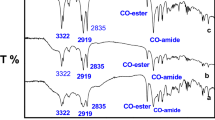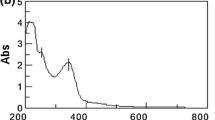Abstract
Four cationic surfactants of quaternary hexammonium silane chloride based on hexamethylenetetramine and alkyl chloride were synthesized. The chemical structures of the prepared cationic surfactants were elucidated using Fourier transform infrared (FT-IR) spectroscopy and mass spectrometry analysis. The surface and thermodynamic properties of the prepared surfactants were also studied. The performance of these cationic surfactants as microfouling agents against two strains of Gram-negative bacteria, namely, Pseudomonas aeruginosa and Escherichia coli, and two strains of Gram-positive bacteria, namely, Staphylococcus aureus and Bacillus subtilis, were evaluated as antimicrobial agents. The results showed that the maximum antimicrobial activity was detected for N-hexamethylenetetramine-N-ethyl silane ammonium trichloride (Ah). The maximum and minimum antimicrobial activities were 73 and 60 % against S. aureus and E. coli, respectively, at a concentration of 5 mg/l, pH 7, and 37 °C.



Similar content being viewed by others
References
Yebra DM, Kiil S, Dam JK (2004) Antifouling technology—past, present and future steps towards efficient and environmentally friendly antifouling coatings. Prog Org Coat 50:75–104
Goncharov VI, Smolin VN (2007) Biofouling of equipment in waste treatment systems. Chem Technol Fuels Oils 43:252–253
Lee AK, Newman DK (2003) Microbial iron respiration: impacts on corrosion processes. Appl Microbiol Biotechnol 62:134–139
Jass J, Walker JT (2000) Biofilms and biofouling. In: Walker JT, Surman S, Jass J (eds) Industrial biofouling: detection, prevention and control. Wiley, New York, pp 1–12
Cloete TE, Jacobs L, Brozel VS (1998) The chemical control of biofouling in industrial water systems. Biodegradation 9:23–37
Shirai A, Sumitomo T, Kurimoto M, Maseda H, Kourai H (2009) The mode of the antifungal activity of gemini-pyridinium salt against yeast. Biocontrol Sci 14:13–20
Hoque J, Akkapeddi P, Yarlagadda V, Uppu DS, Kumar P, Haldar J (2012) Cleavable cationic antibacterial amphiphiles: synthesis, mechanism of action, and cytotoxicities. Langmuir 28:12225–12234
McCarron PA, Donnelly RF, Marouf W, Calvert DE (2007) Anti-adherent and antifungal activities of surfactant-coated poly(ethylcyanoacrylate) nanoparticles. Int J Pharm 340:182–190
Domagk G (1935) Dtsch Med Wochenschr 24:829–832
Klarmann W (1946) Soap Sanit Chemicals 22:125
Brunt KD (1987) In: Hill HC (ed) Biocides for the oil industry. Wiley, New York, pp 201–207
Rozga-Wijas K, Mizerska U, Fortuniak W, Chojnowski J, Hałasa R, Werel W (2007) Quaternary ammonium salts (QAS) modified polysiloxane biocide supported on silica materials. J Inorg Organomet Polym 17:605–613
Dizman B, Elasri MO, Mathias LJ (2006) Synthesis and antibacterial activities of water-soluble methacrylate polymers containing quaternary ammonium compounds. J Polym Sci Part A Polym Chem 44:5965–5973
Kugler R, Boulossa O, Rondelez F (2005) Evidence of a charge-density threshold for optimum efficiency of biocidal cationic surfaces. Microbiol 151:1341–1348
Arnt L, Nusslein K, Tew GN (2004) Nonhemolytic abiogenic polymers as antimicrobial peptide mimics. J Polym Sci Part A Polym Chem 48:3860–3864
Gabrielska J, Sarapuk J, Przestalski S, Wroclaw P (1994) Tenside Surfact Deterg 31:296
Kawabata N, Nishiguchi M (1988) Antibacterial activity of soluble pyridinium-type polymers. Appl Environ Microbiol 54:2532–2535
Caillier L, de Givenchy ET, Levy R, Vandenberghe Y, Géribaldi S, Guittard F (2009) Synthesis and antimicrobial properties of polymerizable quaternary ammoniums. Eur J Med Chem 44:3201–3208
Murray PR, Baron EJ, Pfaller MA, Tenover FC, Yolken HR (1995) Manual of clinical microbiology, 6th edn. ASM Press, Washington, pp 15–18
Olurinola PF (1996) A laboratory manual of pharmaceutical microbiology. Idu, Abuja, pp 69–105
Kaya O, Akçam F, Yaylı G (2012) Investigation of the in vitro activities of various antibiotics against Brucella melitensis strains. Turk J Med Sci 42:145–148
Noor El-Din MR, Al-Sabagh AM, Hegazy MA (2012) Study of the inhibition efficiency for some novel surfactants on the carbon steel (Type H-11) pipelines in 0.5 M HCl solution by potentiodynamic technique. J Dispersion Sci Technol 33:1444–1451
Sayem Alam M, Asit BM (2012) Thermodynamic studies on mixed micellization of amphiphilic drug amitriptyline hydrochloride and nonionic surfactant Triton X-100. J Mol Liq 168:75–79
Pavlikova-Moricka M, Lacko I, Devinsky F, Masarova L, Milynarcik D (1994) Quantitative relationships between structure and antimicrobial activity of new “soft” bisquaternary ammonium salts. J Folia Microbiol (Praha) 39:176–180
Nikaido H (1996) Outer membrane. In: Neidhardt FC (ed) Escherichia coli and Salmonella typhimurium, cellular and molecular biologym. American Society for Microbiology Press, Washington, DC
Gao Y, van Belkum MJ, Stiles ME (1999) The outer membrane of Gram negative bacteria inhibits antibacterial activity of brochocin-C. Appl Environ Microbiol 65:4329–4333
Badawi AM, Hafiz AA (2007) Synthesis and immunomodulatory activity of some novel amino acid germinates. J Iran Chem Soc 4:107–113
Argyropoulou I, Geronikaki A, Paola V, Zani F (2009) Synthesis the biological evalution of sulfonamide thiazole and benzothiazole deriviatives as antimicrobial agents. Arkivoc 4:89–102
Santhakumar K, Kumaraguru N, Arumugham MN, Arunachalam S (2006) Metallomicelles of Co(III) coordination complexes-synthesis, characterization and determination of CMC values. Polyhedron 25:1507–1513
Rosen MJ (2004) Surfactants and interfacial phenomena, 3rd edn. Wiley, New York
Badawi AW, El-Bayouki KhA, Zakria VR (1985) Acetanilide sulphonyl hydrazides and hadrazones of biological activity. Oriental J Chem 1:78
Rosen MJ (1989) Surfactants and interfacial phenomena, 2nd edn. Wiley, New York
Author information
Authors and Affiliations
Corresponding author
Electronic supplementary material
Below is the link to the electronic supplementary material.
About this article
Cite this article
Mohareb, R.M., Badawi, A.M., Noor El-Din, M.R. et al. Synthesis and Characterization of Cationic Surfactants Based on N-Hexamethylenetetramine as Active Microfouling Agents. J Surfact Deterg 18, 529–535 (2015). https://doi.org/10.1007/s11743-014-1662-6
Received:
Accepted:
Published:
Issue Date:
DOI: https://doi.org/10.1007/s11743-014-1662-6




